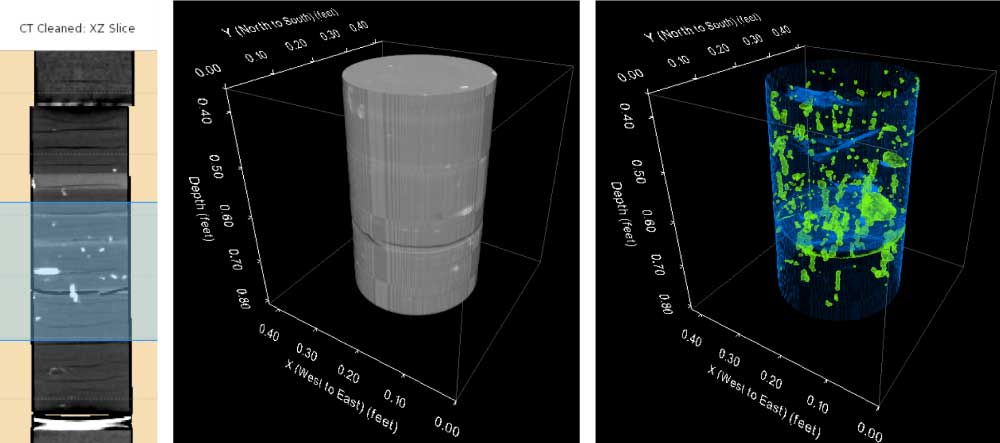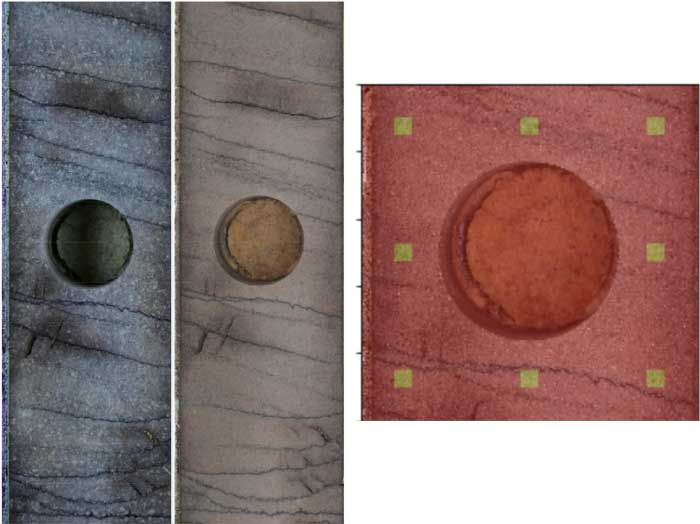CHALLENGE:
- Assimilate heterogeneous data to provide a continuous, high resolution prediction of rock properties across an entire core
- Maintain accuracy of the actual, but sparse plug data when extrapolating to the full core depth
SOLUTION:
- A data processing pipeline for integrating all geologic and petrophysical core data was created on the Virtual Core application
- Textural measurements from core plugs were used to train machine learning models to predict rock and reservoir properties for the full core
RESULTS:
- Process delivered a high resolution estimate of rock properties throughout the entire core
- Confidence levels in results of full core analysis are at the higher threshold provided by plug data
- AI-assisted workflows allows petrophysicists to focus on specific regions and come up with confident evaluations
- Speed and accuracy of analysis of permeability, production, and reserves estimations was greatly increased
- Improvement in expert morale, due to reduced effort towards tedious tasks and delivery of far superior understanding of core properties
Overcome slow and tedious nature of core analysis
Core analysis provides ground truth data of rock properties, and can be time consuming and expensive to collect. Often, measured properties are known only at plug locations within the core, and conventional sampling can miss important heterogeneity that is critical for determining reservoir properties. Core analysis generates a large amount of heterogeneous data, which can be difficult to integrate effectively into a single platform.
From a core section, direct measurement of rock properties, such as permeability, are typically only made at sparsely sampled plug locations. While other information related to the core, such as core photos, gamma-ray and CT measurements are available at high resolution throughout.
The challenge is to assimilate this high resolution data to provide a continuous, high resolution prediction of rock properties across the entire core, with the accuracy of the actual, but sparse plug data.
Use AI and machine learning to identify facies and bedding structures and upscale plug measurements to the entire core section
A data processing pipeline for integrating all geologic and petrophysical core data, including high resolution core photographs and plug testing results, was created on Enthought’s Virtual Core AI analysis and visualization application. Within the Virtual Core application, structural information of the core, such as rock facies and bedding structure was obtained from the high resolution core photographs (Figure 1). A custom tool was created which assimilated these visual characteristics, with a core gamma-ray log, to upscale plug measurements to the entire core section for this data set.
Machine learning was applied to high resolution core photographs to identify facies and bedding using a highly innovative AI technique (Figure 2). Textural measurements were extracted from high resolution photographs at 8 positions surrounding each plug. An AI analytical model was developed which matched this data to its corresponding measured plug data. Based on this AI model, plug measurements were effectively upscaled over the entire length of the core using the high res photographs.
Produced a high resolution estimate of rock properties in a fraction of the time of conventional methods.
The result of these two techniques was a high resolution estimate of rock properties throughout the entire core, with the confidence only to be expected from plug data. This AI-assisted workflows allowed petrophysicists to focus on regions of core with high uncertainty, come up with confident evaluations, and quickly deliver significantly improved analysis of permeability, production and reserves estimations.
Perhaps the most significant improvement was in expert morale. Not only was the drudgery of core analysis removed, far superior understanding was delivered.
Figure 1. The Virtual Core application provides 3D visualization tools that reveal internal sedimentary structures of core.

Figure 2. Textural measurements around core plugs at 8 points were used as features to train machine learning models to predict rock and reservoir properties. Models matched this data to its corresponding measured plug data. Based on this, plug measurements were effectively upscaled over the entire length of the core from high resolution photographs.

In this video, Brendon Hall, Energy Solutions Group at Enthought, introduces the Virtual Core geoscience visualization and analysis application, which enables geoscientists to gather, cleanse, prepare, and visualize all core data as well as integrate log data all in one application.